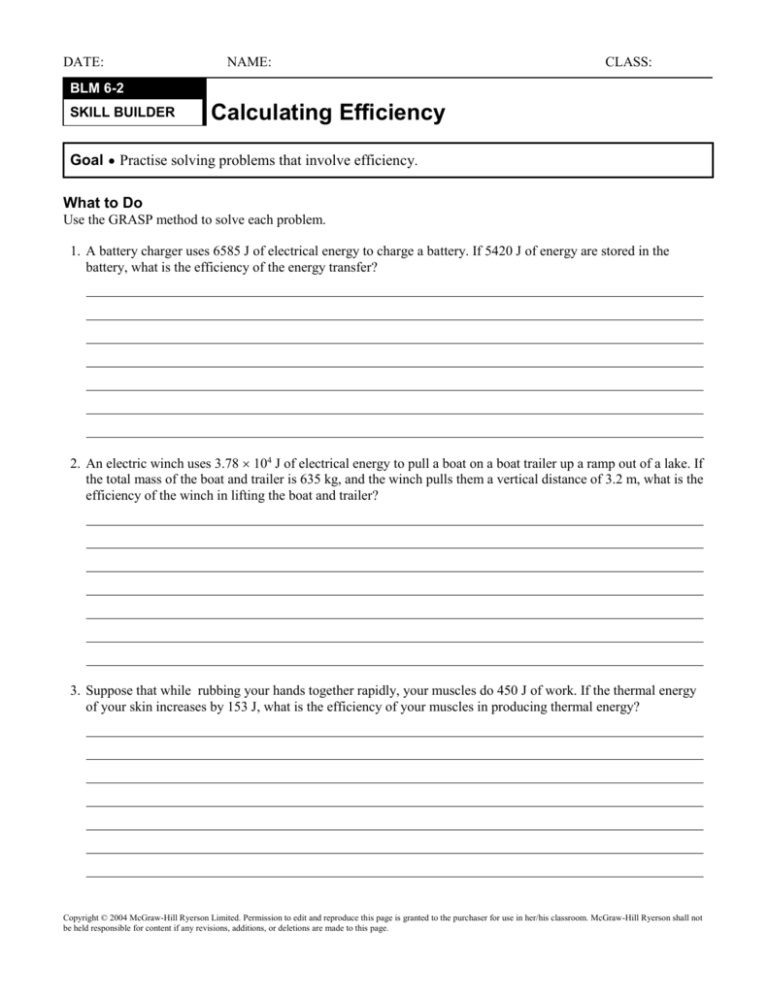BLM6-2
advertisement

DATE: NAME: CLASS: BLM 6-2 SKILL BUILDER Calculating Efficiency Goal Practise solving problems that involve efficiency. What to Do Use the GRASP method to solve each problem. 1. A battery charger uses 6585 J of electrical energy to charge a battery. If 5420 J of energy are stored in the battery, what is the efficiency of the energy transfer? 2. An electric winch uses 3.78 104 J of electrical energy to pull a boat on a boat trailer up a ramp out of a lake. If the total mass of the boat and trailer is 635 kg, and the winch pulls them a vertical distance of 3.2 m, what is the efficiency of the winch in lifting the boat and trailer? 3. Suppose that while rubbing your hands together rapidly, your muscles do 450 J of work. If the thermal energy of your skin increases by 153 J, what is the efficiency of your muscles in producing thermal energy? Copyright © 2004 McGraw-Hill Ryerson Limited. Permission to edit and reproduce this page is granted to the purchaser for use in her/his classroom. McGraw-Hill Ryerson shall not be held responsible for content if any revisions, additions, or deletions are made to this page. DATE: NAME: CLASS: BLM 6-2 SKILL BUILDER Calculating Efficiency (continued) 4. An archer draws her bow and stores 34.8 J of elastic potential energy in the bow. She releases the 63 g arrow, giving it an initial speed of 28 m/s. How efficient is the transfer of the elastic potential energy of the bow to the kinetic energy of the arrow? 5. You are having fun on a water slide. You start from the top of the water slide, which is 2.7 m above the surface of the water. If you enter the water with a speed of 4.8 m/s, how efficient is the water slide in converting your gravitational potential energy into kinetic energy? Assume that your mass is 58 kg. 6. An experimental model rocket has a mass of 0.054 kg. The fuel that was used in one test had 215 J of chemical potential energy. When the rocket reached an altitude of 119 m, it was travelling at 48 m/s and still rising. With what efficiency did the rocket convert chemical potential energy into mechanical energy? Copyright © 2004 McGraw-Hill Ryerson Limited. Permission to edit and reproduce this page is granted to the purchaser for use in her/his classroom. McGraw-Hill Ryerson shall not be held responsible for content if any revisions, additions, or deletions are made to this page. DATE: NAME: CLASS: BLM 6-2 SKILL BUILDER Calculating Efficiency (continued) 7. Some school physics laboratories have a device called a ballistic pendulum. In a ballistic pendulum, a springloaded launcher fires a metal sphere into a cavity in a pendulum bob, causing the pendulum to rise. Suppose that a spring-loaded launcher gives a 750 g sphere a speed of 1.5 m/s. The sphere is caught in the cavity of the pendulum bob, which had a mass of 125 g without the sphere. If the pendulum bob and sphere rise to a vertical height of 7.2 cm, what is the efficiency of the ballistic pendulum in converting the kinetic energy of the metal sphere into gravitational potential energy of the pendulum and sphere? 8. A farmer is thinking about using a small waterfall on his property to generate hydro-electric energy. He determines that 3155 kg of water fall a distance of 15 m every minute. Assuming that the process is 74 percent efficient, how much electrical energy could he generate every minute? Copyright © 2004 McGraw-Hill Ryerson Limited. Permission to edit and reproduce this page is granted to the purchaser for use in her/his classroom. McGraw-Hill Ryerson shall not be held responsible for content if any revisions, additions, or deletions are made to this page.






